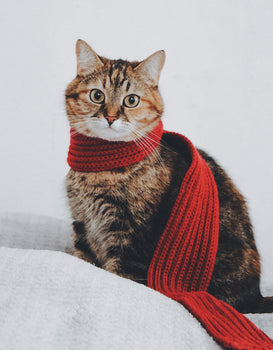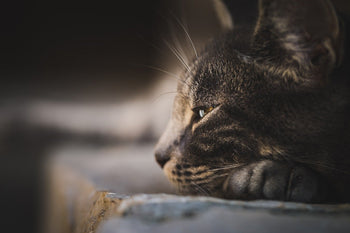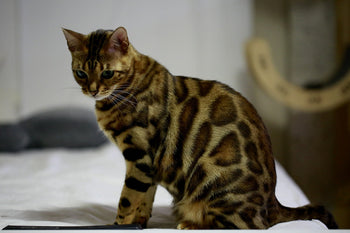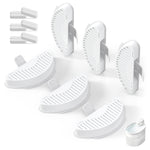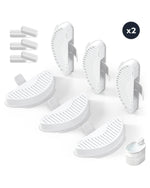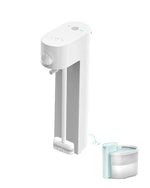Are Plastic Water Fountains Safe for Cats?
Plastic water fountains are a popular choice for pet owners looking to provide their furry friends with a constant supply of fresh water. While these fountains can be a convenient and hygienic option, many cat owners wonder if they are safe for their feline companions. In this article, we will explore the question of whether plastic water fountains are OK for cats and provide some key takeaways for cat owners to consider.
Understanding Cat's Needs Cats have unique needs when it comes to their water consumption. They are obligate carnivores, which means that they require a diet that is high in protein and moisture. In the wild, cats get most of their water from their prey, and they have a low thirst drive compared to other animals. This is why it's important for cat owners to provide their pets with a source of fresh, clean water that is easily accessible.
Evaluating Plastic Water Fountains Plastic water fountains can be a convenient option for cat owners, as they provide a constant supply of fresh water and can be easily cleaned. However, there are some potential concerns to consider when it comes to using plastic water fountains for cats. Some cats may be sensitive to the chemicals found in plastic, which can leach into the water over time. Additionally, plastic fountains can be more difficult to clean than other materials, which can lead to the growth of bacteria and other pathogens.
Key Takeaways
- Cats have unique needs when it comes to their water consumption, and it's important for cat owners to provide a source of fresh, clean water that is easily accessible.
- While plastic water fountains can be a convenient option, they may not be suitable for all cats due to concerns about chemical leaching and difficulty of cleaning.
- When considering a plastic water fountain for their cat, owners should evaluate the materials used, the ease of cleaning, and any potential sensitivities their cat may have to plastic.
Understanding Cat's Needs

Natural Instincts and Hydration
Cats have a natural instinct to drink water that is fresh and clean. In the wild, they would get most of their water from the prey they hunt. However, domestic cats rely on their owners to provide them with water. It is essential to ensure that the water is fresh and clean at all times. Cats are also sensitive to the temperature of the water. They prefer water that is at room temperature or slightly cooler.
Benefits of Using Water Dispensers
Water dispensers are a great way to provide cats with a continuous supply of fresh water. They come in different shapes and sizes, and some even have filters that remove impurities from the water. Using a water dispenser ensures that your cat always has access to fresh water, even when you are not around to refill their water bowl.
Advantages of Continuous Fresh Water Supply
Cats need a constant supply of fresh water to stay hydrated. Dehydration can lead to serious health problems, such as urinary tract infections and kidney disease. Providing a continuous supply of fresh water can help prevent these health issues and keep your cat healthy.
Encouraging Cats to Drink More Water
Some cats are picky drinkers and may not drink enough water. There are several things you can do to encourage your cat to drink more water. One way is to provide multiple water sources throughout your home. You can also add flavor to the water by adding a small amount of tuna juice or chicken broth. Another way is to use a water fountain, which can be more enticing to cats than a stagnant water bowl.
Related Posts:
Evaluating Plastic Water Fountains
When it comes to choosing a water fountain for your cat, plastic fountains are one of the most popular options available in the market. However, before making a purchase, it is important to evaluate the different aspects of plastic water fountains to make an informed decision.
Different Types of Water Dispensers
There are different types of water dispensers available in the market, including gravity-fed, pump-operated, and pressure-activated fountains. Plastic fountains are available in all three types, and each has its own set of advantages and disadvantages.
Pros and Cons of Plastic Dispensers
Plastic water fountains are lightweight, affordable, and easy to clean. They come in a variety of designs and sizes, making it easy to find one that suits your cat's needs. However, plastic fountains are prone to scratches, which can harbor bacteria and other harmful microorganisms. Additionally, plastic fountains may contain chemicals that can leach into the water and harm your cat's health.
Economic and Durability Aspects of Plastic Fountains
Plastic fountains are generally more affordable than ceramic or stainless steel fountains. However, they may not last as long, and may need to be replaced more frequently. It is important to consider the cost of replacement and maintenance when choosing a plastic fountain.
Safety and Health Concerns Related to Plastic
Plastic fountains may contain BPA, phthalates, and other harmful chemicals that can leach into the water. These chemicals can have a negative impact on your cat's health, and may cause health problems in the long run. Additionally, plastic fountains are prone to scratches, which can harbor bacteria and other harmful microorganisms.
Related Posts:
Uhapet Brand Overview
Introduction to Uhapet as a Reputable Manufacturer
Uhapet is a well-known manufacturer of high-quality pet products, including automatic water fountains for cats. They are dedicated to providing pet owners with reliable and safe products that promote the health and well-being of their furry friends. With years of experience in the pet industry, Uhapet has built a strong reputation for producing innovative and effective products that cater to the unique needs of pets.
Unique Features and Advantages of Uhapet Fountains
Use of High-Quality, BPA-Free Plastic in Uhapet Products
Uhapet is committed to using only the highest quality materials in their products. Their fountains are made from BPA-free plastic, which is safe for pets to drink from and won't leach harmful chemicals into the water. Additionally, Uhapet fountains are built to last, with durable construction that can withstand regular use.
Commitment to Safe and Reliable Water Dispensers for Cats
Uhapet is dedicated to providing pet owners with safe and reliable water dispensers for their cats. They conduct rigorous testing on all of their products to ensure that they meet the highest standards of quality and safety. Additionally, Uhapet offers excellent customer service and support, ensuring that pet owners have access to assistance and guidance whenever they need it.
Related Posts:
Conclusion
In conclusion, plastic water fountains can be a convenient and affordable option for cat owners who want to provide their feline friends with a constant supply of fresh water. However, it's important to keep in mind that not all plastic fountains are created equal.
When choosing a plastic water fountain for your cat, look for one that is made from high-quality, BPA-free materials and is easy to clean. Consider the size and shape of the fountain to ensure that it will fit comfortably in your home and that your cat will be able to use it easily.
It's also important to note that some cats may prefer other types of water sources, such as a simple bowl or a ceramic fountain. Pay attention to your cat's preferences and behavior to determine what type of water source is best for them.
Overall, plastic water fountains can be a great option for cats, but it's important to choose one carefully and pay attention to your cat's individual needs and preferences.
Frequently Asked Questions
What materials are considered safest for cat water fountains?
When it comes to materials, stainless steel and ceramic are considered the safest for cat water fountains. These materials are non-toxic, durable, and easy to clean. Plastic water fountains, on the other hand, may contain harmful chemicals that can leach into the water and harm your cat’s health.
How often should cat water fountain filters be replaced to ensure safety?
To ensure the safety of your cat, it is recommended to replace the filters of cat water fountains every 2-4 weeks. This is because the filters can become clogged with debris, which can lead to bacterial growth and contamination of the water. Regular filter replacements will help to keep the water clean and fresh.
What are the benefits of using a cordless cat water fountain?
Cordless cat water fountains are battery-operated and more convenient than their wired counterparts. They can be placed anywhere in your home without the need for a power source. Additionally, cordless cat water fountains are safer as there is no risk of electrocution.
Can the use of cat water fountains lead to illness in cats?
While cat water fountains are generally safe, improper maintenance can lead to bacterial growth and contamination of the water. This can lead to illness in cats if they consume contaminated water. To prevent this, it is important to regularly clean and replace the filters of the cat water fountain.
How can I prevent electrocution risks with cat water fountains?
To prevent electrocution risks, it is important to ensure that the cat water fountain is properly grounded and that the cord is not damaged. Additionally, it is recommended to use a cordless cat water fountain to eliminate the risk of electrocution completely.
What steps can be taken to minimize bacteria growth in cat water fountains?
To minimize bacteria growth in cat water fountains, it is important to regularly clean and replace the filters. Additionally, it is recommended to use stainless steel or ceramic materials as they are less likely to harbor bacteria. Finally, it is important to change the water in the cat water fountain regularly to prevent the growth of harmful bacteria.
Related Posts:
- How to Maintain a Wireless Cat Water Fountain?
- The Battle of the Bowls: Wireless Cat Water Fountains vs. Wired Cat Water Fountains
- Troubleshooting Tips for Your Wireless Cat Water Fountain
- How Does a Wireless Cat Water Fountain Work? A Clear Explanation






